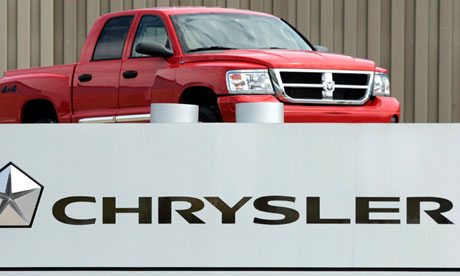
Chrysler's sales rose 14% compared to August 2011 to 148,472, its best August sales figure since 2007. Photograph: Rebecca Cook/Reuters
According to reports, auto sales were steeply up for the month of November, with experts holding to an increase in the seasonally adjusted annual rate (SAAR) of between 15.0-15.4% – a four-year high. Some have been quick to suggest superstorm Sandy as a key cause, creating a spike in trade as people were forced to replace storm-damaged vehicles.
Not so fast. Here are five reasons why the November boost may not be as large as we're told – and why Sandy may not be "to blame".
1. Much of the overall boost comes from other factors
Sales for the whole year were already at a four-year high. Back at the beginning of October, auto sales experts said that this "robust pace was fed by consumers replacing older vehicles, the wide variety of new fuel-efficient models on the market and the greater availability of credit at low interest rates."
September's car sales helped push the SAAR to its highest in four years, at 14.9%. October and November continued this torrent of sales. Both months, like each one over the last year, featured gains in car sales year on year. Sandy may have helped make November's SAAR higher than September's, but the difference is about half a million cars or fewer – and that's not enough to account for why November 2012 was so much better than 2011.
2. The jump in car sales from October to November is less than the number of cars damaged by Sandy
We can't quite know yet how many people will eventually buy new carsbecause their autos, more than 230,000 overall, were lost in the storm. In addition, about 30,000 sales were lost in October. Put together, we might assume that there were 260,000 fewer cars on the road after Sandy.
November's sales, however, only rose by about 20,000 units over October's. We can't say whether or not car sales would actually have fallen in November in a universe without Sandy. Sales did fall this time last year, by 2.52%; instead, in 2012, November's sales improved on October's, but only by 1.11%. That hardly adds up to a Sandy bonanza.
3. Percentage change hides the smallness of the gains
If I tell you that Ford deliveries increased by 6.4% from November 2011 to November 2012, it sounds like a very impressive figure. What if I told you that Ford deliveries were up from 166,441 in November 2011 to 177,092 in November 2012? That sounds slightly less impressive. If these car deliveries were vote totals in an election, 2012 car sales would only be up by 3 percentage points.
4. Any Sandy boost fits the historical pattern
If the car industry did, in fact, see a boost because of Sandy, it was well expected. Jessica Caldwell of Edmunds.com noted in November that "we know there will be increased interest in both new and used vehicles as people replace vehicles damaged in the storm." Analysts pointed to how people bought more cars after Katrina – once they received theirinsurance payout.
We can see this foresight in the auto business forecasts. While both Ford and Nissan topped industry predictions, the much-talked-about 14% Chrysler gains actually fell short of the mean 16% gains predicted by the Bloomberg aggregated average of experts.
5. The overall market shares remain fairly constant
It would be notable if one company was able to pick up an edge over competitors after Sandy. At first glance, this doesn't seem to be the case.
Ford was up 4.9% on the year through October, and deliveries at 6.4% in November show an apparent continuation of that trend. General Motors deliveries rose to 3.4%, as compared to its 3.6% increase in yearly sales through October. Nissan sales up 13% in November is fairly close to their year-to-date growth of 10.5%. Meanwhile, Toyota and Honda had through October, and in November, gains of over 15% from a year ago.
Overall, any effect that Sandy has over the long term on the market seems relatively minor. Sandy or no Sandy, car sales were all year, and continue to be now, a hot business in America.
No comments:
Post a Comment